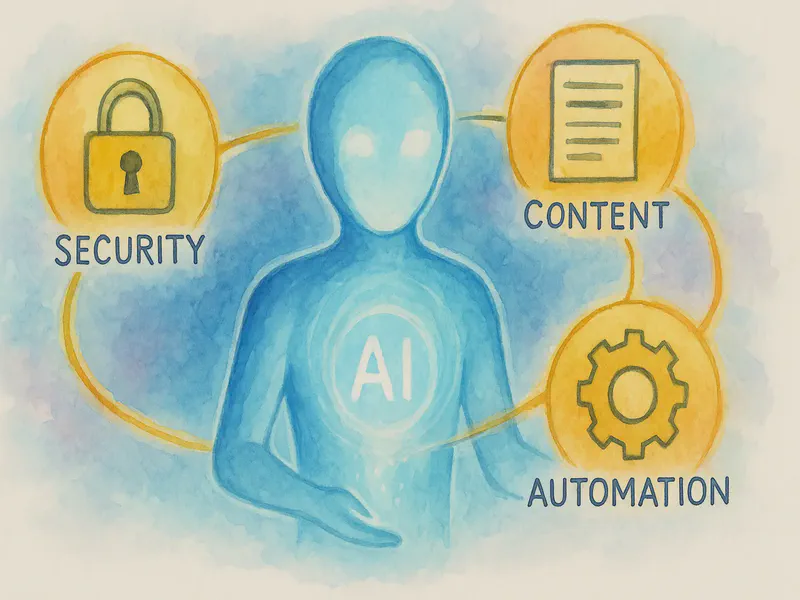
Building AI-Powered Life Management Systems: The AWS Infrastructure Approach
- Stephen Jones
- Dev ops
- September 6, 2025
Table of Contents
Daniel Miessler just dropped a fascinating deep-dive into building what he calls a “Personal AI Infrastructure” (PAI) - essentially an AI-powered life management system that handles everything from content creation to security assessments. While his approach uses Claude Code and local tooling, it got me thinking about how we could architect something similar using AWS services.
The core insight from Miessler’s system isn’t the specific tools - it’s the architectural philosophy: solve problems once, make them modular, and orchestrate intelligently. That’s pure AWS thinking right there.
The AWS Translation
Let’s break down Miessler’s PAI components and see how they map to AWS services:
Context Management → Amazon Bedrock Knowledge Bases
Miessler’s file-based context system (~/.claude/context/) is brilliant, but imagine this powered by Amazon Bedrock Knowledge Bases. Instead of manually organizing markdown files, you get:
- Automatic embedding generation for all your documentation
- Semantic search across your entire knowledge base
- RAG-powered context injection that finds exactly the right information
- Version control and access patterns built-in
# CloudFormation snippet
BedrockKnowledgeBase:
Type: AWS::Bedrock::KnowledgeBase
Properties:
Name: PersonalAIKnowledgeBase
DataSource:
S3Configuration:
BucketArn: !GetAtt ContextBucket.Arn
InclusionPrefixes:
- "context/projects/"
- "context/methodologies/"
- "context/philosophy/"
Agent Orchestration → Amazon Bedrock Agents
Miessler’s specialized agents (engineer, pentester, designer) become Bedrock Agents with:
- Action Groups that connect to your AWS services
- Automatic tool discovery through API schemas
- Session persistence across conversations
- Built-in guardrails for safety
Commands & Tools → AWS Lambda + Step Functions
Those custom commands (write-blog-post, create-custom-image) become Lambda functions orchestrated by Step Functions:
# Lambda function example
import boto3
import json
def lambda_handler(event, context):
bedrock = boto3.client('bedrock-runtime')
# Extract context from Knowledge Base
context = get_relevant_context(event['query'])
# Generate content using Bedrock
response = bedrock.invoke_model(
modelId='anthropic.claude-3-sonnet-20240229-v1:0',
body=json.dumps({
'messages': [{'role': 'user', 'content': f"{context}\n\n{event['prompt']}"}],
'max_tokens': 4000
})
)
return process_response(response)
MCP Servers → API Gateway + Lambda
Miessler’s MCP servers running on Cloudflare Workers? That’s basically API Gateway + Lambda with better AWS integration:
- Native iam integration for security
- CloudWatch monitoring out of the box
- VPC connectivity for private resources
- Cost optimization with Lambda’s pay-per-request model
The Architecture That Makes Sense
Here’s how I’d architect this on AWS:
┌─────────────────┐ ┌──────────────────┐ ┌─────────────────┐
│ Amazon Q │ │ Bedrock Agents │ │ Knowledge Bases │
│ (Interface) │◄──►│ (Orchestration) │◄──►│ (Context) │
└─────────────────┘ └──────────────────┘ └─────────────────┘
│ │ │
▼ ▼ ▼
┌─────────────────┐ ┌──────────────────┐ ┌─────────────────┐
│ Step Functions │ │ Lambda Funcs │ │ s3 Storage │
│ (Workflows) │◄──►│ (Tools) │◄──►│ (Artifacts) │
└─────────────────┘ └──────────────────┘ └─────────────────┘
Key AWS Services in Play:
- Amazon Q Developer as the primary interface
- Amazon Bedrock for AI orchestration and knowledge management
- AWS Lambda for modular tool execution
- Amazon s3 for artifact storage
- AWS Step Functions for complex workflows
- Amazon EventBridge for event-driven automation
- AWS Systems Manager Parameter Store for configuration
The “Solve Once, Reuse Forever” Pattern
This is where AWS really shines. Miessler talks about solving problems once and turning them into reusable modules. In AWS terms:
- Build a Lambda function for any repetitive task
- Package it in SAM/CDK for easy deployment
- Expose via API Gateway for universal access
- Orchestrate with Step Functions for complex workflows
- Monitor with CloudWatch for reliability
Example: A “security assessment” workflow becomes:
SecurityAssessmentWorkflow:
Type: AWS::StepFunctions::StateMachine
Properties:
Definition:
StartAt: TechStackDetection
States:
TechStackDetection:
Type: Task
Resource: !GetAtt HttpxFunction.Arn
Next: PortScanning
PortScanning:
Type: Task
Resource: !GetAtt NaabuFunction.Arn
Next: VulnerabilityAnalysis
VulnerabilityAnalysis:
Type: Task
Resource: !GetAtt SecurityAnalysisFunction.Arn
End: true
The Real Power: AWS Integration
What makes this approach superior to Miessler’s local setup:
1. Native AWS Service Integration
Your AI system can directly interact with:
- EC2 instances for infrastructure management
- RDS databases for data analysis
- CloudFormation stacks for deployment automation
- Cost Explorer for FinOps insights
2. Enterprise-Grade Security
- iam roles for fine-grained permissions
- VPC isolation for sensitive workloads
- AWS KMS for encryption at rest and in transit
- CloudTrail for complete audit logs
3. Scalability & Reliability
- Auto-scaling based on demand
- Multi-AZ deployment for high availability
- Managed services reduce operational overhead
- Pay-per-use pricing for cost efficiency
Implementation Strategy
If you’re building this, here’s the approach I’d recommend:
Phase 1: Foundation
- Set up Bedrock Knowledge Base with your documentation
- Create basic Lambda functions for common tasks
- Build a simple Bedrock Agent for orchestration
Phase 2: Automation
- Add Step Functions for complex workflows
- Implement EventBridge rules for event-driven automation
- Create API Gateway endpoints for external integrations
Phase 3: Intelligence
- Fine-tune Bedrock models with your specific use cases
- Implement advanced RAG patterns for better context
- Add monitoring and optimization with CloudWatch Insights
The Business Case
This isn’t just cool tech - it’s a competitive advantage:
- Faster decision-making through automated intelligence gathering
- Reduced operational overhead via intelligent automation
- Better security posture through continuous assessment
- Cost optimization through AI-driven FinOps analysis
Summary
Miessler’s PAI concept is brilliant, but implementing it on AWS gives you enterprise-grade capabilities with managed services. You get the same “solve once, reuse forever” philosophy with better security, scalability, and integration.
The key insight: don’t just build AI tools, build AI infrastructure. Make it modular, make it AWS-native, and make it work for your specific goals.
Objectives:
- Understand the architectural patterns behind AI-powered life management
- Map personal AI infrastructure concepts to AWS services
- Design scalable, secure systems using managed AWS services
Deliverables:
- AWS architecture blueprint for personal AI infrastructure
- Implementation strategy with phased approach
- Integration patterns for enterprise-grade AI systems
Start with Amazon Bedrock and a simple Knowledge Base. Add Lambda functions for your most common tasks. Build from there.
The future of productivity isn’t just having AI tools - it’s having AI infrastructure that grows with you and integrates with everything you already use.
I hope someone else finds this useful.
References:


